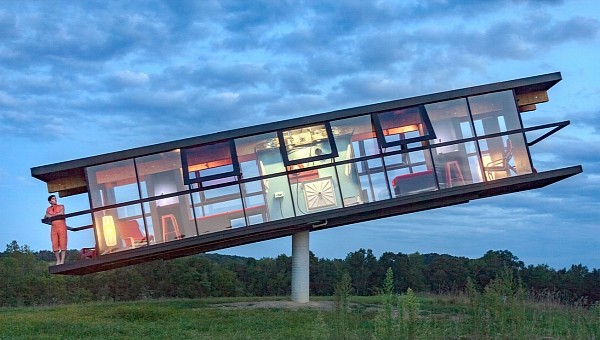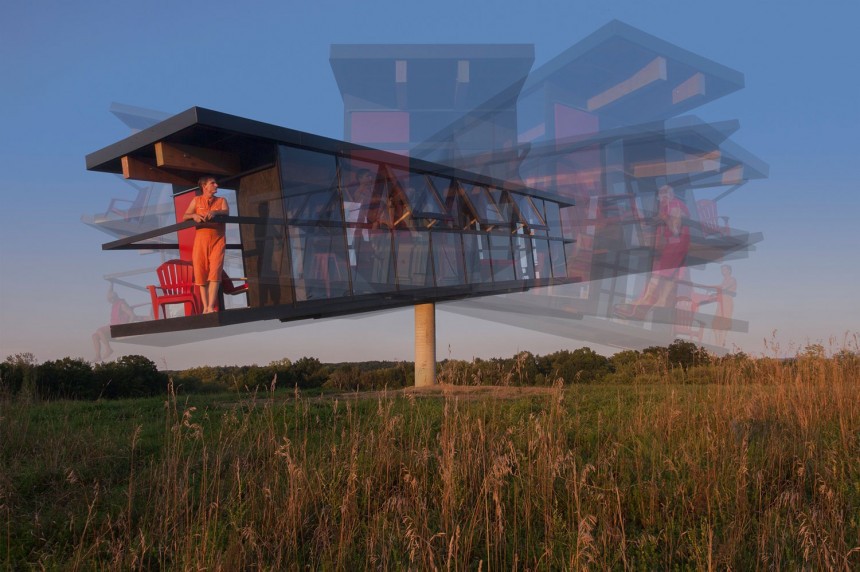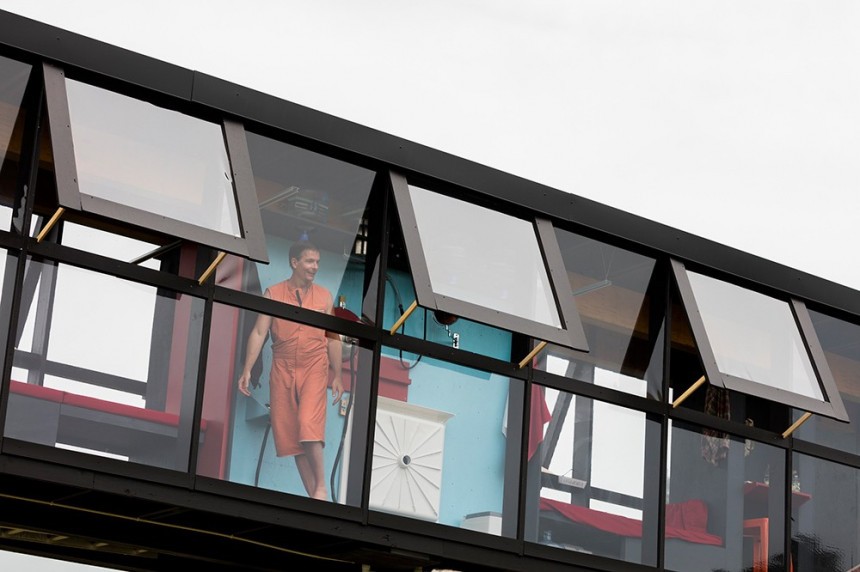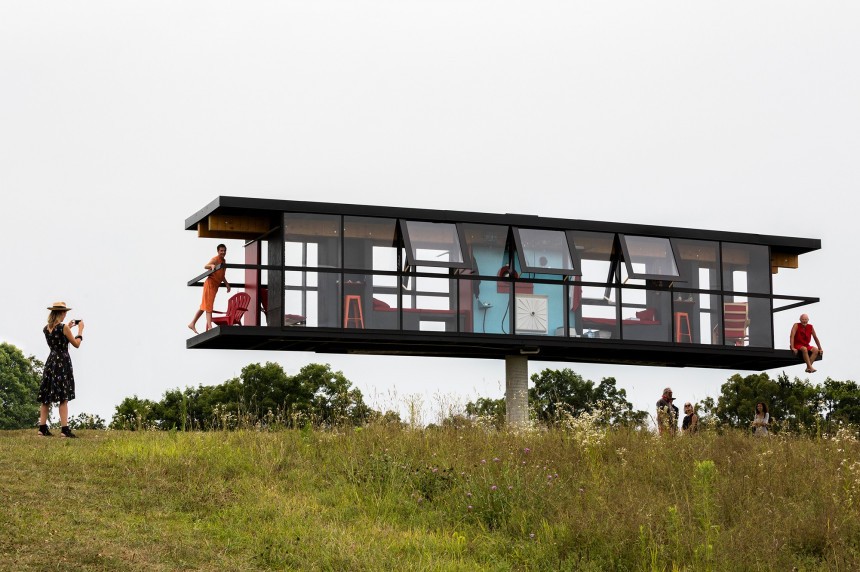Not all mobile homes have wheels, and yet they’re still perfectly capable to deliver that much-coveted outdoor experience. ReActor is one such home, while also being one of the most daring and famous architectural art pieces of recent years.
ReActor is a mobile home, in the most basic sense of the word: it moves, though it never relocates. Unlike the mobile homes we usually cover here, which range from tiny homes to easy-to-assemble prefabs and container homes, van and bus conversions, luxurious RVs, and mega-trailers, ReActor doesn’t move from place to place. Because it’s built on the same principles as a weather vane, it spins in place and tilts from one side to the other, depending on the forces that act upon it.
Rotating homes are not new, and ReActor doesn’t claim to break the mold here. They’re still curiosities, though, built out of a desire for something that sits outside the norm and delivers an ever-changing view depending on the speed of the rotation and your location inside the house.
The idea of weather-vaning homes is not new, either. Former pilot Thomas Bennington proposed putting a converted Boeing 727 home on a pole and having it spin in the wind way back in 1998. He called that a Wind Resistant Building, one that would come in very handy during natural disasters like hurricanes and floods. His idea never took off (pun intended), mostly because of the large costs the airplane conversion and the new foundation would have required, but it did cause quite a stir in the media.
ReActor is at the intersection of all this, while also being its own thing. It’s actually a piece of performance art and what artist duo Alex Schweder and Ward Shelley call “performance architecture,” a phrase they coined for their own brand of art, which combines architecture with sculpture and the performative side of it.
Designed and built in 2016, ReActor is a functional home for two adults, with floor-to-ceiling glazing, sitting on top of a single cement pole that keeps it 15 feet (4.5 meters) off the ground. The design of the home is similar to that of a railway cart, with mirrored spaces spread over a platform that is 44 feet (13.5 meters) long and 8 feet (2.5 meters) wide. It offers two bedrooms, a shared but fully-equipped kitchen, and a shared bathroom, with open balconies at either end.
The “get” of ReActor is the fact that a hinge that connects it to the cement pole allows it to spin 360 degrees, depending on the wind. If the residents move around inside the house, it tilts accordingly, so they have to be in constant communication to prevent the home from becoming a sloped surface. Think of it like a seesaw – a house-shaped seesaw for two adults.
“The structure rotates in response to its inhabitants’ movements, exterior forces, and interior conditions, making visible the intimate relationship between architecture and its inhabitants,” the artists said at the time.
For a period of five days, Schweder and Shelley lived inside the house, which was erected on-site, on top of a hill at the OMI Art Center in the Hudson Valley, near Ghent, in upstate New York. During this time, the Art Center was open to the public, so visitors could see how the two residents’ interactions influenced the movements of the house, and how they ended up cooperating to keep it stable. “Stable” is one way of putting it because, even in perfect balance, ReActor still swayed gently in the wind. Again, its design was based on a weather vane, so it moved (and creaked) at the slightest breeze.
The goal of the project was to show the different possible uses of wood as a construction material, as well as how architecture shapes and impacts relationships between residents. According to the artists, the project was “based on the notion that relationships between occupied spaces and occupying subjects are permeable.”
In other words, the house forced the two residents to collaborate and communicate, which is something that modern architecture doesn’t do anymore. At the end of those five days, the artists said they were surprised at how pleasant their stay inside ReActor had been, even keeping in mind that they had been in a fishbowl, with people gawking at them constantly.
ReActor remained on site until 2018, and its whereabouts are currently unknown. For all the emphasis on how it was a fully functional home, given its constant state of motion, it could have never been more than just an art piece – though one could argue that it would have made for an interesting overnight rental. YouTubers and travel vloggers would have probably jumped at the chance for such a unique experience.
As far as mobile houses go, ReActor is the one with the less range (if you will allow the pun), but it’s definitely artsy enough to make up for it.
Rotating homes are not new, and ReActor doesn’t claim to break the mold here. They’re still curiosities, though, built out of a desire for something that sits outside the norm and delivers an ever-changing view depending on the speed of the rotation and your location inside the house.
The idea of weather-vaning homes is not new, either. Former pilot Thomas Bennington proposed putting a converted Boeing 727 home on a pole and having it spin in the wind way back in 1998. He called that a Wind Resistant Building, one that would come in very handy during natural disasters like hurricanes and floods. His idea never took off (pun intended), mostly because of the large costs the airplane conversion and the new foundation would have required, but it did cause quite a stir in the media.
Designed and built in 2016, ReActor is a functional home for two adults, with floor-to-ceiling glazing, sitting on top of a single cement pole that keeps it 15 feet (4.5 meters) off the ground. The design of the home is similar to that of a railway cart, with mirrored spaces spread over a platform that is 44 feet (13.5 meters) long and 8 feet (2.5 meters) wide. It offers two bedrooms, a shared but fully-equipped kitchen, and a shared bathroom, with open balconies at either end.
The “get” of ReActor is the fact that a hinge that connects it to the cement pole allows it to spin 360 degrees, depending on the wind. If the residents move around inside the house, it tilts accordingly, so they have to be in constant communication to prevent the home from becoming a sloped surface. Think of it like a seesaw – a house-shaped seesaw for two adults.
“The structure rotates in response to its inhabitants’ movements, exterior forces, and interior conditions, making visible the intimate relationship between architecture and its inhabitants,” the artists said at the time.
The goal of the project was to show the different possible uses of wood as a construction material, as well as how architecture shapes and impacts relationships between residents. According to the artists, the project was “based on the notion that relationships between occupied spaces and occupying subjects are permeable.”
In other words, the house forced the two residents to collaborate and communicate, which is something that modern architecture doesn’t do anymore. At the end of those five days, the artists said they were surprised at how pleasant their stay inside ReActor had been, even keeping in mind that they had been in a fishbowl, with people gawking at them constantly.
As far as mobile houses go, ReActor is the one with the less range (if you will allow the pun), but it’s definitely artsy enough to make up for it.













